- News
- Reviews
- Bikes
- Accessories
- Accessories - misc
- Computer mounts
- Bags
- Bar ends
- Bike bags & cases
- Bottle cages
- Bottles
- Cameras
- Car racks
- Child seats
- Computers
- Glasses
- GPS units
- Helmets
- Lights - front
- Lights - rear
- Lights - sets
- Locks
- Mirrors
- Mudguards
- Racks
- Pumps & CO2 inflators
- Puncture kits
- Reflectives
- Smart watches
- Stands and racks
- Trailers
- Clothing
- Components
- Bar tape & grips
- Bottom brackets
- Brake & gear cables
- Brake & STI levers
- Brake pads & spares
- Brakes
- Cassettes & freewheels
- Chains
- Chainsets & chainrings
- Derailleurs - front
- Derailleurs - rear
- Forks
- Gear levers & shifters
- Groupsets
- Handlebars & extensions
- Headsets
- Hubs
- Inner tubes
- Pedals
- Quick releases & skewers
- Saddles
- Seatposts
- Stems
- Wheels
- Tyres
- Health, fitness and nutrition
- Tools and workshop
- Miscellaneous
- Cross country mountain bikes
- Tubeless valves
- Buyers Guides
- Features
- Forum
- Recommends
- Podcast
£399.99
VERDICT:
Fast, stable and ultra-reliable entry-level road bike that forgoes fireworks for long-term and long-distance enjoyment
Weight:
11,440g
Contact:
At road.cc every product is thoroughly tested for as long as it takes to get a proper insight into how well it works. Our reviewers are experienced cyclists that we trust to be objective. While we strive to ensure that opinions expressed are backed up by facts, reviews are by their nature an informed opinion, not a definitive verdict. We don't intentionally try to break anything (except locks) but we do try to look for weak points in any design. The overall score is not just an average of the other scores: it reflects both a product's function and value – with value determined by how a product compares with items of similar spec, quality, and price.
What the road.cc scores meanGood scores are more common than bad, because fortunately good products are more common than bad.
- Exceptional
- Excellent
- Very Good
- Good
- Quite good
- Average
- Not so good
- Poor
- Bad
- Appalling
The Triban RC120 Disc is an entry-level road bike with mechanical disc brakes from Continental budget bike maestro Triban/Decathlon. With almost faultless ride manners, a perfectly practical spec and the extra incentive of that enhanced stopping power, the RC120 Disc has more potential as a high-mileage road machine than its price might suggest.
- Pros: All-round surefooted ride performance, easy-to-live-with frame geometry, brakes better than expected
- Cons: Little bit heavy, shifters feel a little plasticky, misses just a touch of excitement
> Find your nearest Decathlon store here
The Ride
I've mainly been testing flat-bar commuting bikes and hybrids over the last 12 months, but hopping aboard the Triban RC120 Disc was like reconnecting with an old friend. That's great news for the new or lapsed road cyclists who this entry-level bike is aimed at. Handling is absolutely secure with very little upsetting the Triban's progress. It's comfortable too, both in terms of position and in its ability to filter out the worst of your route's road surfaces.
That bump isolation doesn't come at the cost of efficiency. Start turning up the wick a little and power delivery is decent: keeping a high cruising tempo is a particularly satisfying pleasure. Fast flat sections or moderate climbs are dealt with ease and even more testing challenges benefit from the RC120 Disc's stable ride, which allows out-of-the-saddle efforts to be handled without drama. It is pretty much exactly what anybody wanting a friendly, benign road bike would hope for.
Really take the bike by the horns, though, and there is a slight blemish. The most noticeable is that accelerating and sprinting are less rewarding than high-speed cruising. Part of the reason for that can be attributed to some of the speccing and design choices, such as the 28mm tyres and sturdy wheels, which are hardly unrefined bloaters but just enough to take the edge off from-the-line sprightliness.
Meanwhile, the relatively large (by contemporary standards) rear triangle and tall head tube creates a nice 'n' high riding position that, while far from turgid, feels just a little less lively than some.
Frame
Of course that geometry does have its perks. Even for creaky old fools who prefer life on the hoods, it's not too intimidating and actually tempting to get down on the drops. If you'd rather stay upright, it's a bike that you could happily tick along on for hours. The overall weight of almost 11.5kg seems a tad lardy, though.
In terms of the frame, the 6061 T6 aluminium has been manipulated so we have a range of tube shapes, such as the massive square-edged down tube.
The RC120 doesn't have the undersize rear triangle found on other Tribans further up the range, but that's fine – I quite like the fact that Triban's lower models eschew fashion and retain some more traditional design details. Indeed, even the compact frame's sloping top tube is probably seen as slightly old-fashioned these days.
Leading the way out front is a carbon bladed fork. It's effective at taking the sting out of the road and it even features front rack mounts should you want to turn this into an ultra-fast tourer.
Front-end control is excellent, as I am very happy to attest to. During testing, it was certainly responsive enough to steer me out of the way of an oncoming car that had careered three-quarters of the way across my lane, desperate to nip up a side road. (It's the only time I've had drivers pull alongside me afterwards like a team car to compare notes about how close I was to being squashed.)
Gears and brakes
When it comes to mechanical performance, the Triban exceeds expectations and the relatively low-rent componentry has a secure feel to it all. Connoisseurs won't confuse the Microshift front mech (not Shimano front derailleur, as listed on Decathlon's website), rear mech and shifters with Mr Shimano's finest – they're not as smooth or quiet in operation – but gear changes are positive and didn't miss a beat in the Triban's time with me. The shifters are probably the weakest part of that trio because, although the hoods are comfy, the general operation feels just a little plasticky.
One gift from Japan via Malaysia is the Shimano Tourney compact (50/34) chainset which, combined with the 8-speed 11-34t Microshift cassette, offers a really broad range of gearing ratios. To be honest, I've become so used to using 1x systems recently, I rarely got out of the big ring at the front, but everything performed well.
Rather against my expectations, that positivity extends to the Promax mechanical disc brakes, which are quietly impressive. Modulation is definitely better than the typical cheapo calliper brakes found at this point in the market and outright power is good, too. Add in the potential to retain your braking ability in the rain, and any potential purchaser who decides to upgrade to this model over the £350 rim-braked Triban RC120 is, in my opinion, making a very wise choice.
Wheels and components
Part of the reason for the brakes' effectiveness comes thanks to the 28mm ResistProtect+ clincher tyres I mentioned earlier. As I said, they might dampen bursts of acceleration slightly, but high-tempo cruising seems to run a nice course between comfort, stability and efficiency. They provide really good grip and just enough security without completely taking the edge off of the Triban's quest for speed.
In any case, you might not want to keep these clincher tyres as they are because the Triban RC120 Disc has another ace up its sleeve: tubeless ready wheels. The own-brand aluminium rims roll smoothly on sealed hubs and certainly don't detract from the ride quality, and having the option to go tubeless on a £400 bike (yeah, okay £399.99) is very nice indeed.
While the fairly standard aluminium stem and seatpost spark few thrills, there are some other quite positive speccing touches.
For the type of newbie riders who are most likely to buy the Triban RC120 Disc, a saddle will no doubt be an exciting first upgrade but there's no need to rush into it because the Triban Ergofit is more than good enough to get you started.
I also liked the ergonomic, almost wing-like handlebar, which provides plenty of room to rest your palms on top of the chunky bar tape.
Value and conclusion
There was a time when Triban/B'Twin completely ruled the roost at the entry end of the 'proper' road bike market, but the brand doesn't have it all its own way anymore. The £420 Pinnacle Laterite 1 has a classy and slightly more sporty aluminium frame, carbon fork, Shimano Claris 2x8-speed setup and Tektro calliper brakes. Meanwhile, over at Halfords, the Carrera Vanquish Disc features an alloy frame, carbon fork, Claris gearset and Tektro mechanical discs for £425.
> Buyer's Guide: 9 of the best road bikes under £500
But another aspect in the Triban RC120 Disc's favour is its obvious potential versatility. For relatively inexperienced riders, it's a very safe welcome to the world of fast drop-bar bikes. With rack mounts front and back, it could also be a high-speed commuter. And for more experienced hands, with that potential to go tubeless, it could make for a surprisingly effective aluminium winter training bike too.
It also unquestionably upholds its forebears' honour as an entry-level option that offers a real road-bike ride experience. If you prefer long-ride comfort, stability and efficiency to occasional short blasts, it would be hard to better the Triban RC120 Disc at this price.
Verdict
Fast, stable and ultra-reliable entry-level road bike that forgoes fireworks for long-term and long-distance enjoyment
road.cc test report
Make and model: Triban RC120 Disc Road Bike
Size tested: L
About the bike
List the components used to build up the bike.
Frame: 6061 T6 aluminium compact geomtery with tall head tube, rear rack mounts and mudguard mounts
Fork: Carbon-bladed with 1 1/8in steerer and front rack mounts and mudguard mounts
Front derailleur: Microshift
Rear derailleur: Microshift
Chainset: Shimano Tourney compact double 50/34t
Cassette: Microshift 11-34t
Shifters: Microshift
Brakes: Promax DSK-300R mechanical discs
Wheels: Triban tubeless ready
Tyres: 28mm ResistProtect+
Saddle: Triban Ergofit
Seatpost: Triban aluminium
Stem: Triban aluminium
Handlebar: Triban ergonomic aluminium
Tell us what the bike is for and who it's aimed at. What do the manufacturers say about it? How does that compare to your own feelings about the bike?
This is an entry-level road bike aimed at new riders, returning road riders or even commuters.
Triban/Decathlon says: "Cycle with confidence on this versatile Triban RC120 Disc road bike. It's been developed by our designers with 2x8 speeds, comfort geometry, aluminium sloping frame and lightweight carbon fork to enable you to make progress with your cycling on any type of road. Exceptional brake control comes courtesy of the effective mechanical disc brakes."
Where does this model sit in the range? Tell us briefly about the cheaper options and the more expensive options
The Triban RC120 Disc sits towards the bottom of the Triban range with only the non-disc Triban RC120 (£349.99) and RC100 (£249.99) below it.
The RC500 Disc with Shimano Sora is £529.99. The RC520 Disc with 105 is £729.99.
The RC520 Gravel Adventure Bike is £849.99.
Frame and fork
Overall rating for frame and fork
8/10
Tell us about the build quality and finish of the frame and fork?
The frame is quite nicely made, although I'm not a huge fan of the preponderance of square-edged tubing. Strangely, though, it looks a lot better in real than on the Decathlon website.
Tell us about the materials used in the frame and fork?
The frame is made from 6061 T6 aluminium. The fork is carbon bladed with a 1 1/8in aluminium steerer and front rack mounts.
Tell us about the geometry of the frame and fork?
Quite a relaxed geometry with a tall head tube providing a relatively high riding position.
How was the bike in terms of height and reach? How did it compare to other bikes of the same stated size?
Good. I would say the reach was perhaps just a fraction longer than I would have expected.
Riding the bike
Was the bike comfortable to ride? Tell us how you felt about the ride quality.
Very comfortable. The ride quality focuses mostly on comfort and stability.
Did the bike feel stiff in the right places? Did any part of the bike feel too stiff or too flexible?
No undue flex that I could tell – stiff enough.
How did the bike transfer power? Did it feel efficient?
Good power transfer for cruising and climbing.
Was there any toe-clip overlap with the front wheel? If so was it a problem?
No toe overlap.
How would you describe the steering? Was it lively neutral or unresponsive? Neutral – certainly responsive enough but nowhere near twitchy.
Tell us some more about the handling. How did the bike feel overall? Did it do particular things well or badly?
In terms of handling, it's a real pleasure to ride, as long as you're not looking for too much excitement. Really allows you to push on without worry.
Which components had the most effect (good or bad) on the bike's comfort? would you recommend any changes?
The 28mm tyres enhanced comfort a little and the Ergofit saddle was beneficial, too.
Which components had the most effect (good or bad) on the bike's stiffness? would you recommend any changes?
Tyres – you might be tempted to swap them out if you're looking for thrills.
Which components had the most effect (good or bad) on the bike's efficiency? would you recommend any changes?
It felt pleasingly efficient to me – I wouldn't swap much. However, when it comes to improving sprinting and acceleration, some lighter wheels are worth thinking about.
Rate the bike for efficiency of power transfer:
8/10
Very good.
Rate the bike for acceleration:
6/10
I felt there was a little bit left wanting.
Rate the bike for sprinting:
7/10
Easy to get out of the saddle and bike handled well, but acceleration is still not optimised.
Rate the bike for high speed stability:
9/10
Really good at high speeds.
Rate the bike for cruising speed stability:
10/10
Its cruising performance is its strongest suit – excellent!
Rate the bike for low speed stability:
9/10
Still very good.
Rate the bike for flat cornering:
9/10
Easy to know exactly what the bike is doing underneath you.
Rate the bike for cornering on descents:
9/10
Very good.
Rate the bike for climbing:
9/10
I quite enjoyed climbing on the RC120 – it seemed to take on hills very well.
The drivetrain
Rate the drivetrain for performance:
7/10
Drivetrain isn't very plush but it worked faultlessly.
Rate the drivetrain for durability:
8/10
Hard to know how durable Microshift kit is, but it looks sturdy.
Rate the drivetrain for weight:
6/10
This and the rest of the bike could do with going on a moderate sensible eating plan.
Rate the drivetrain for value:
5/10
Tell us some more about the drivetrain. Anything you particularly did or didn't like? Any components which didn't work well together?
I was impressed by it – gear changes were solid and gear choices were very sensible. It doesn't feel as swift as better options, but there's very little practical to complain about.
Wheels and tyres
Rate the wheels for performance:
7/10
Rolled nicely and seemed well up to the job but a little heavy.
Rate the wheels for durability:
7/10
Rate the wheels for weight:
5/10
At 2.2kg for the pair, these are quite heavy hoops.
Rate the wheels for comfort:
9/10
In concert with the tyres, very good.
Rate the wheels for value:
8/10
Tell us some more about the wheels.Did they work well in the conditions you encountered? Would you change the wheels? If so what for?
As long as you're happy to put up with slightly compromised accelerating performance, these will make for reliable winter training and daily duty wheels.
Rate the tyres for performance:
7/10
I was impressed generally by the tyres, although they also slightly took the edge off acceleration.
Rate the tyres for durability:
7/10
Rate the tyres for weight:
7/10
Rate the tyres for comfort:
9/10
I was impressed and they seemed to add to the overall high comfort levels.
Rate the tyres for value:
8/10
Tell us some more about the tyres. Did they work well in the conditions you encountered? Would you change the tyres? If so what for?
All good on dry roads and slightly damp roads; I haven't tested them in full wet conditions.
Controls
Rate the controls for performance:
8/10
Fine – handlebar was particularly good.
Rate the controls for durability:
7/10
Fairly standard aluminium construction, so should last.
Rate the controls for weight:
7/10
Again, fairly standard.
Rate the controls for comfort:
9/10
The ergonomic bar offered good palm positioning and the saddle was a nice surprise, too.
Rate the controls for value:
8/10
Tell us some more about the controls. Any particularly good or bad components? How would the controls work for larger or smaller riders?
The RC120 Disc comes with an 80mm stem which, with a relatively long reach in the frame already, some riders might want to swap.
Anything else you want to say about the componentry? Comment on any other components (good or bad)
Promax mechanical disc brakes were very good – far better than I expected – with reliable modulation, decent power, and unhindered wet weather performance.
Your summary
Did you enjoy riding the bike? Yes
Would you consider buying the bike? Yes
Would you recommend the bike to a friend? Yes
How does the price compare to that of similar bikes in the market, including ones recently tested on road.cc?
The £420 Pinnacle Laterite 1 has a slightly more sporty aluminium frame, carbon fork, Shimano Claris 2x8-speed setup and Tektro calliper brakes. Meanwhile, at Halfords, the Carrera Vanquish Disc features an alloy frame, carbon fork, Claris gearset and Tektro mechanical discs for £425.
Rate the bike overall for performance:
9/10
Rate the bike overall for value:
9/10
Use this box to explain your overall score
For anybody wanting a real and agreeable road bike experience on a budget, the Triban RC120 Disc is hard to beat. It might lose a little in top-end excitement, but it does everything else very well.
About the tester
Age: 39
I usually ride: Islabikes Beinn 29 My best bike is: 25-year-old Dawes Galaxy
I've been riding for: Over 20 years I ride: Most days I would class myself as: Experienced
I regularly do the following types of riding: commuting, touring, sportives, general fitness riding, mountain biking, leisure
Latest Comments
- David9694 5 min 46 sec ago
"Ah well, it was just an accident" seems to have become one of the most important ideas in the active travel campaigner's world. I guess the ...
- Rendel Harris 11 min 37 sec ago
Depends where you are but last year a DPD driver I reported was NIP'd by the Met after I submitted a video of him parking on the zigzags of a zebra...
- eburtthebike 32 min 29 sec ago
Thanks, I'll give it a listen.
- Rendel Harris 51 min 15 sec ago
Not really Blaupunkt though, sadly: the company was liquidated in 2016 following bankruptcy. It's just a trademark now that's licensed to various...
- whosatthewheel 1 hour 59 min ago
He won't be "jailed" for life as it will not be a "whole life" sentence. He's 22 now, so may be out as early as when he is 37 as the minimum "jail"...
- BigSigh 11 hours 16 min ago
I am absolutely certain that it's not fair for trans-identifying males who went through male puberty to compete in female sports... and that should...
- chrisonabike 12 hours 31 min ago
Nothing to do with cycling, and currently unclear as to what exactly happened. But a child is dead, a tram line isn't running services and ...
- Destroyer666 11 hours 44 min ago
Sidelining the point here a little bit, but I was just looking at a Rapha video about Lachlan Morton's latest incredible venture of riding 648km in...
- wtjs 15 hours 22 min ago
Or, you can just look at them - it's pretty obvious when they're not going to work with a new chain. Then you can try them with old lengthened...



































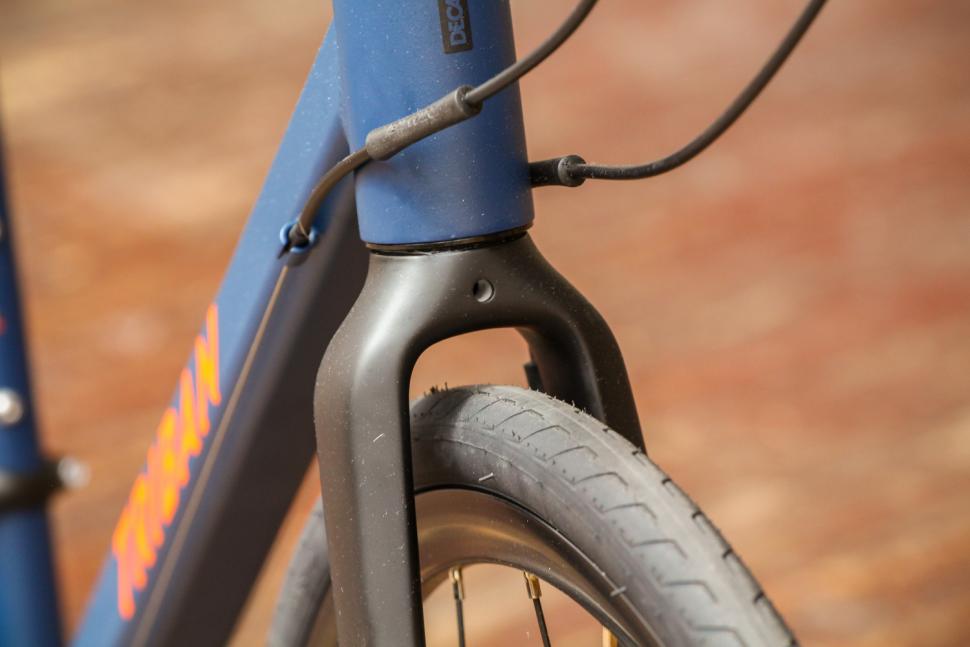
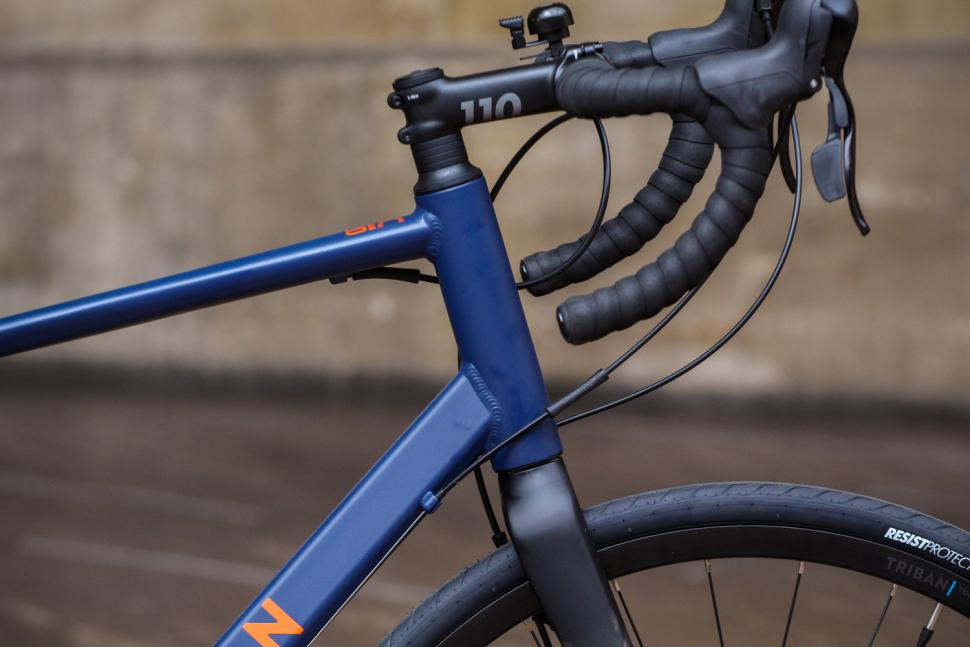
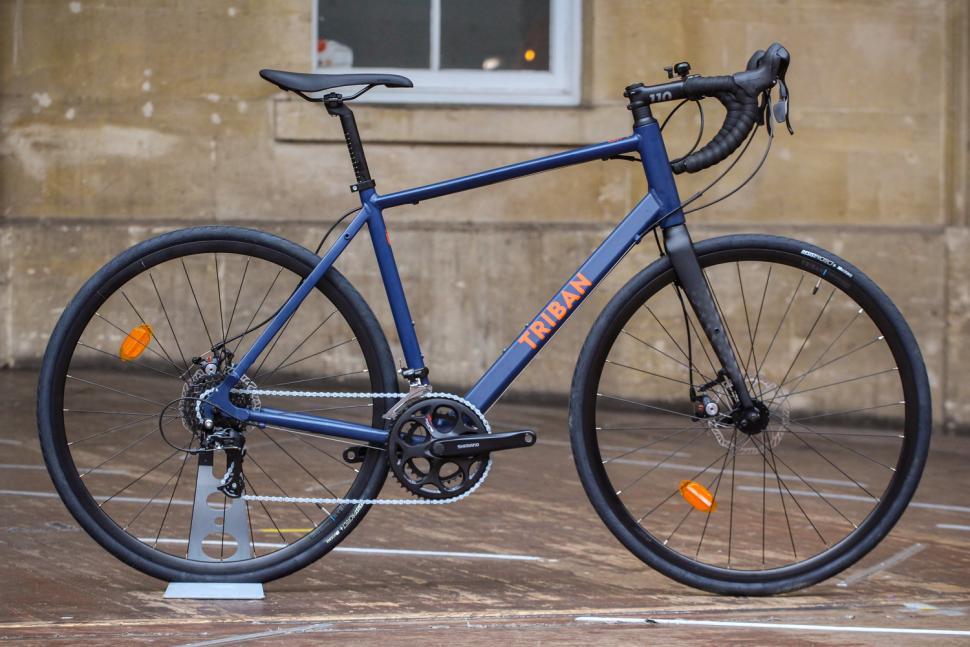
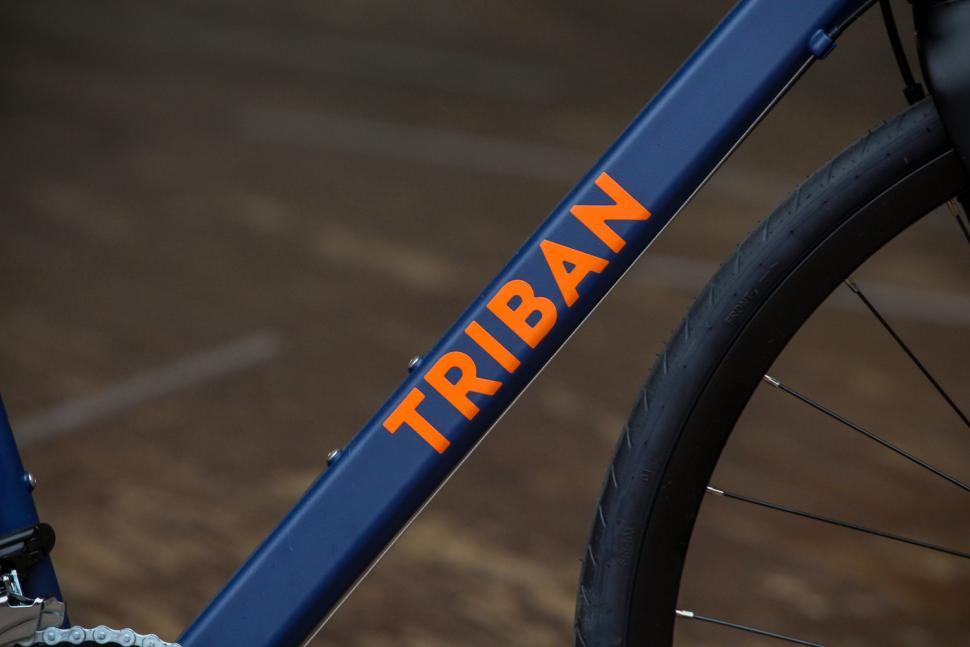
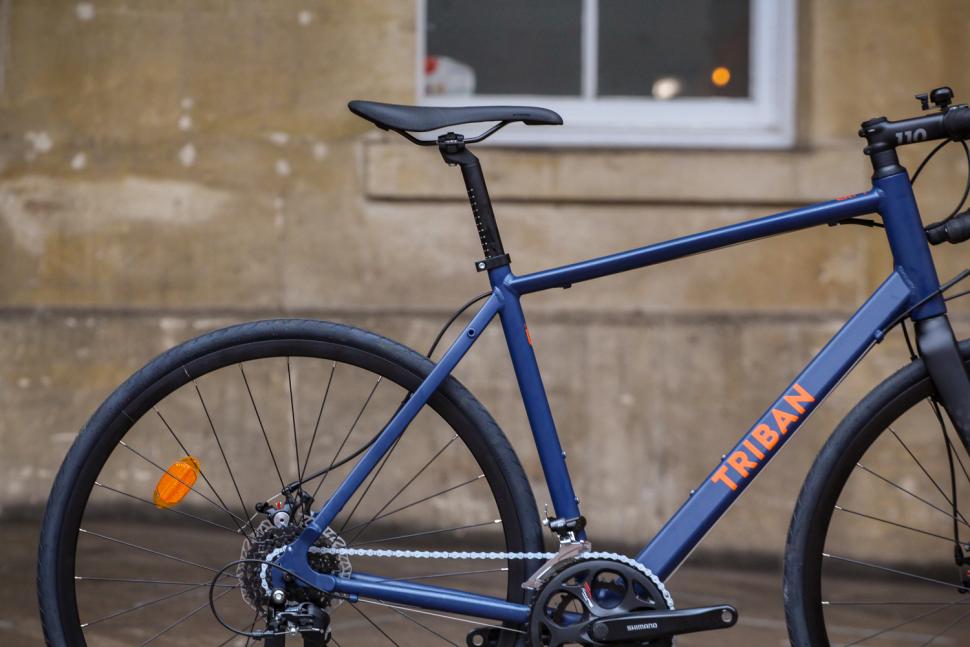


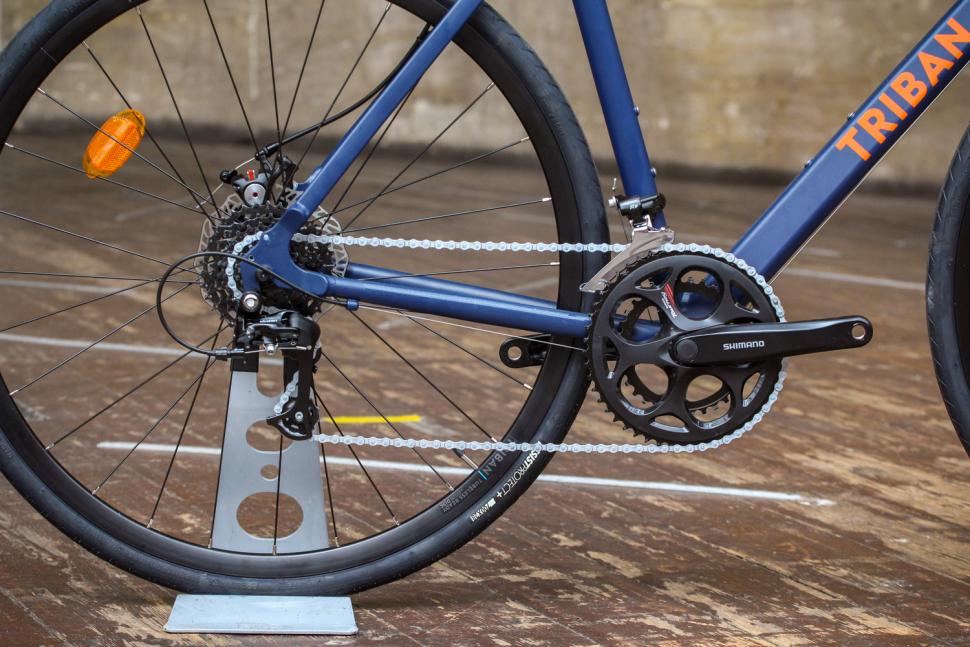



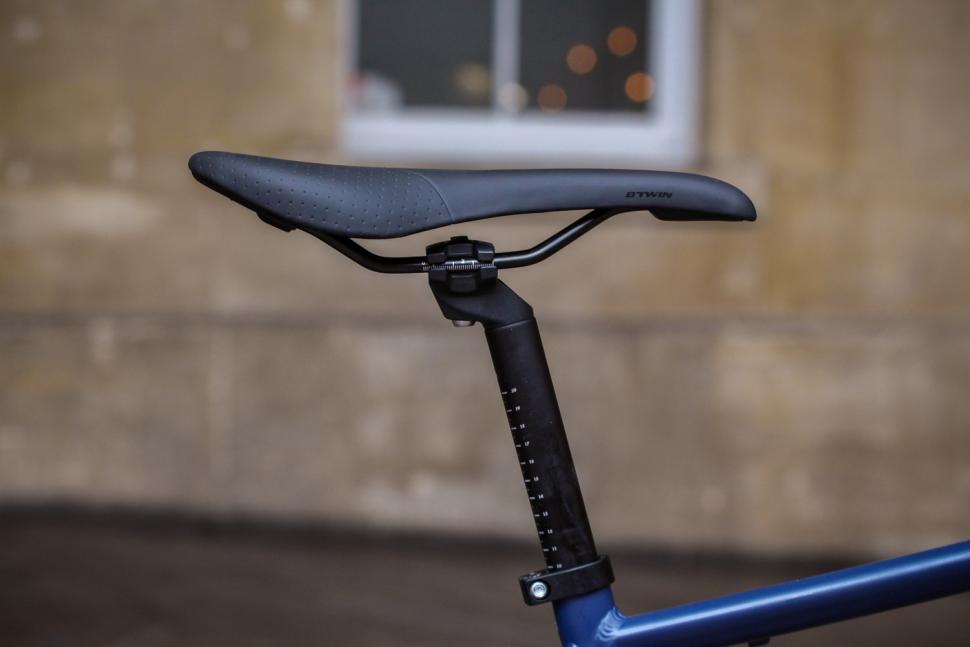
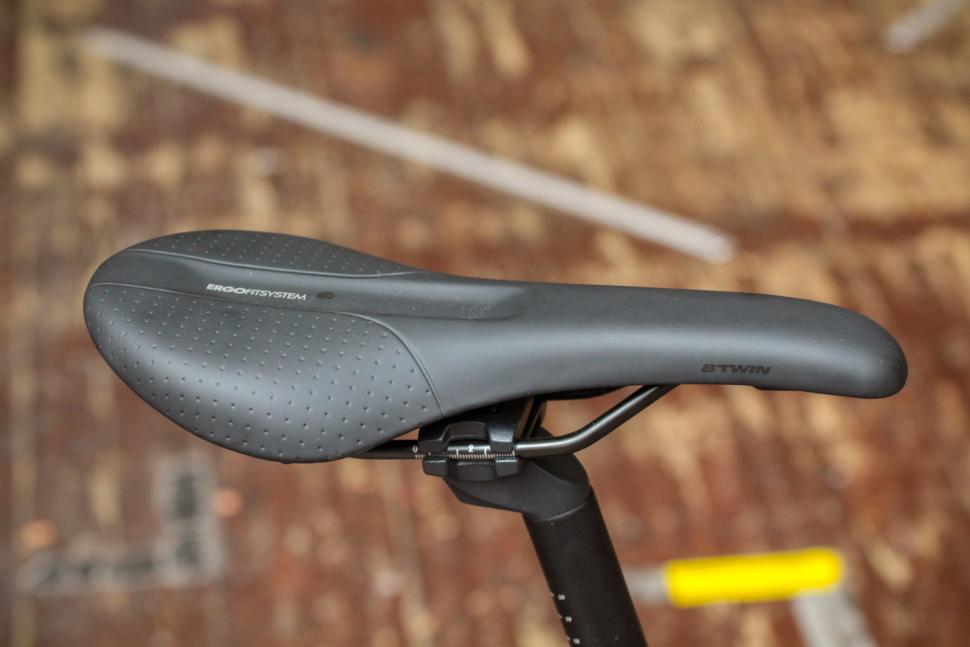
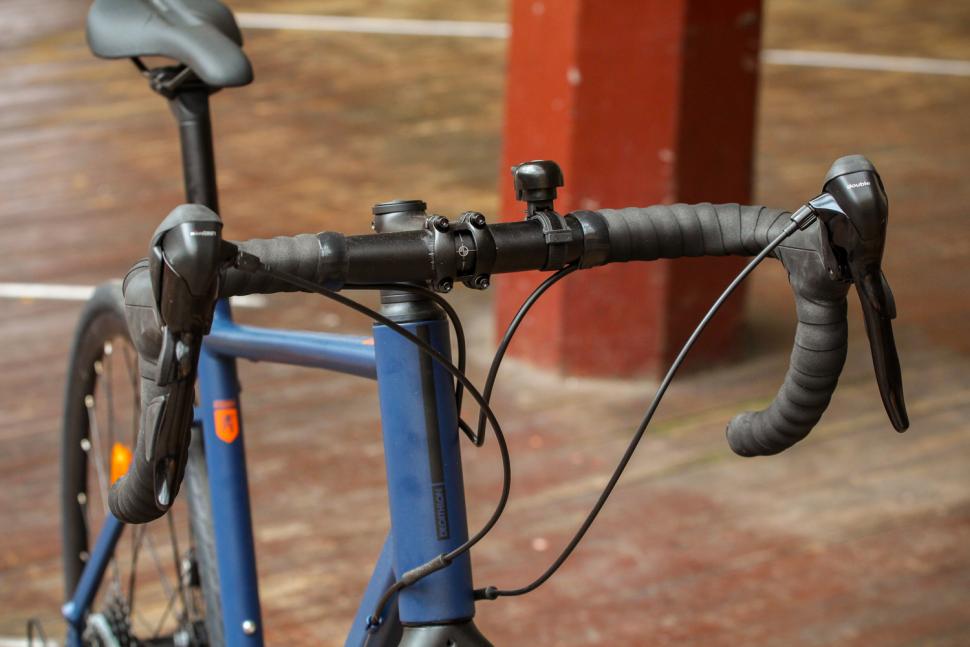




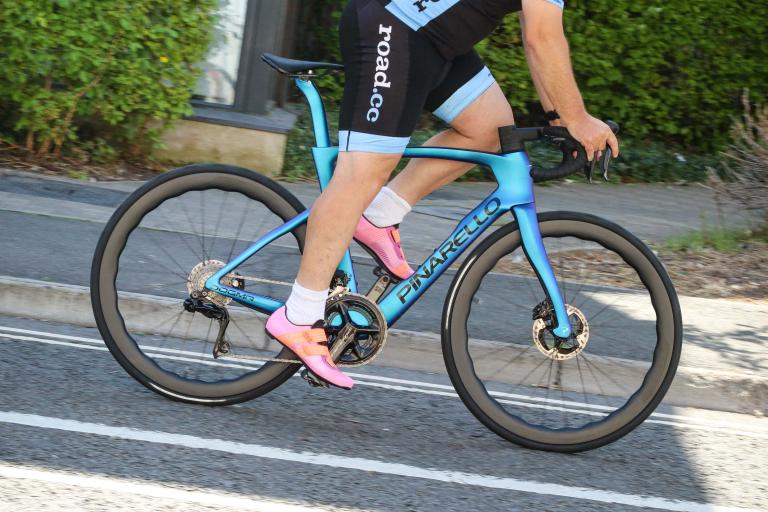
Add new comment
11 comments
For the money I can't fault the rim brake predecessor. I've had mine just over a year and done just over 4000miles. I've replaced the chain and cassette twice and will probably have to change them and the chain set too and I replaced a rear spoke but for the abuse it gets that's acceptable to me.
For £400 is there a better [priced/spec Winter Bike available?
I'm tempted myself, if I didn't already have a winter bike, I'd get this and spec up the groupset, saddle and wheels but like the reviewer says there's not much to swap out. You'd probably lose near enough a kilo from doing that and bingo!
That Klamper caliper does indeed look lovely and I'm sure is fabulously well-engineered, but my, £350 for a pair! Quite a bit more than, say, a complete set of 105-level hydraulic levers + calipers. You'd have to really love the thing to invest!
A bit off topic, as this thread is for comments about a bargain bike that will provide a far better and more quality ride than the price would seem to justify, but, last night I discovered that the esoteric Paul's Components make a cable actuated disk brake, shockingly expensive, of course, with additional costs you'd probably pay more for two calipers than this entire bicycle. It's called the Klamper, looks flash and I'm guessing provides very good braking, with complete stripdown possible and positively encouraged. Mmmm, Paul's...
Disc brake pad replacement is very easy, easier than rim brakes in my opinion.
Cable-disc brakes benefit hugely from the use of compressionless cable housing.
I have trp spyres on one of my bikes. They're no worse than rim brakes, and probably better than the flexy long drop calipers I have on my mudguarded single speed. I can't speak to cheaper disc brakes, though.
OK, I'll bite... here are my humble opinions.
I have ridden rim brakes a fair bit (dual pivot side pulls, V brakes, cantilevers, Mafac centre pulls in the 1980s, and those awful steel single pivot nonsenses that came with your typical Raleigh Dreadful back in the 1970s).
I now have a cable-disc CX bike (with TRP Spyres), and when buying that bike tried it against a 105 hydraulic disc bike. The hydraulics are a lot nicer - the modulation is really very seductive indeed and there's nothing to adjust (I'm told). I had to choose between those and a nicer frame and went for the latter.
Against ordinary dual-pivot side pulls (as you'd see on a bike where there's been a bit of penny-pinching and you don't get the full groupset), I think they are a bit better. You can certainly brake harder and get to the limit of the tyres' grip sooner and the modulation is perfectly fine. They feel less squidgy to me. And in the wet I never worry, though side pulls are perfectly OK for me in the wet as well, given decent pads and a bit of looking ahead, due caution, get your PR on a dry day, etc.
Having recently written off some rims due to brake track wear, it's nice not to have to worry about that, and I can easily see if the rotors are gone.
I don't get the maintenance thing vs rim brakes (though I do get it vs hydraulics). The technique is different - there are little adjuster screws that move the pistons rather than mucking about pulling cables through clamps once you get to the end of the inline adjuster travel. I'm happy with that.
Downsides: They're loud in the wet. It's a nasty moany-drony noise. Pad wear is much less obvious than on rim brakes, and refitting wheels is trickier. I have had pad replacements done during services by the LBS so can't comment on that, but it doesn't look very tricky, especially on brakes where both pads move. Those are all problems with hyraulics too, I guess.
So in summary, they are nothing like as bad as people seem to think. Whether they are right in a particular context is another matter - I'd agree 100% that the extra money on this Triban might be better spent elsewhere.
And which of the brakes I have ridden would I want on my N+1? Those Mafac centre pulls. Dreamy.
This 100%
I have received the same wisdom about disk brakes, but have never myself tested it. I'd be grateful if someone who has long experience could summarise why mechanical disks are reputed to be worse than rim brakes, and how hydraulic disks overcome the shortcomings of both. Not that I doubt what has been said, I just would like to understand.
And, anyone out there to defend mechanical disks?
Cable disk brakes are OK, I ran Avid BB5s on a mountain bike for a couple of years. They are somewhat comparible to rim brakes, better than some and worse than others. Good rim brakes are in my opinion better than cable disk brakes, except when it rains and the rim gets wet or muddy. In this case, the consistency of a disk brake is preferable.
Once you've use hydraulic disk brakes, it's difficult to accept anything else. I'm running Shimano XT Hydraulics on my MTB and SRAM Force Hydraulics on my road/gravel bike and they are both amazing. Tons of modulation, totally consistent and you can stop on a dime with very little effort.
Nice review, but I’d challenge that the disk Triban is the one to get. The difference in price between rim £350 and disk £420 is huge at that level.
The rim bike is a kilo lighter, would be more fun to ride and far easier to maintain - cable disk brakes are a PITA to get right, I wouldn’t want someone new to cycling doing that.